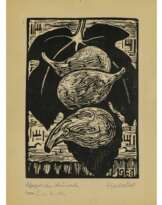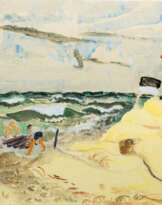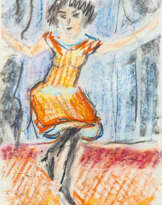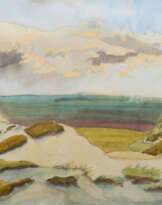ID 904220
Lot 248 | Erich Heckel (Döbeln 1883 - Radolfzell/Bodensee 1970). Die Westerholzmühle.
1928. Schwarze Kreide und Tuschfeder. 55,5 x 69,5 cm. R. u. sign. und dat. Heckel 28 sowie betitelt, unter Glas gerahmt, ungeöffnet. - Provenienz: Galerie Michael Neumann, Kiel, vor 1994. - H. war einer der bedeutendsten Vertreter des Expressionismus. Er gehörte nach einem kurzen Architekturstudium 1905 neben Schmidt-Rottluff, Kirchner und F. Bleyl zu den Mitbegründern der 'Brücke' in Dresden. Nach zahlreichen Reisen und längerer Ateliergemeinschaft mit Kirchner zog er 1911 in das Kunstzentrum Berlin, wo er mit anderen dem Expressionismus zum internationalen Durchbruch verhalf. Den Ersten Weltkrieg durchlebte er als Sanitäter in Flandern, wo er M. Beckmann und J. Ensor traf. In der Zeit der Weimarer Republik erhielt er zahlreiche öffentliche und private Aufträge; bereits 1931 wurde sein Lebenswerk mit einer großen Ausstellung geehrt. Die Nationalsozialisten vernichteten eine große Anzahl seiner Werke; der Künstler zog sich an den Bodensee zurück. Nach dem Zweiten Weltkrieg würdigten zahlreiche Ausstellungen und Auszeichnungen seine Bedeutung, u.a. stellte er 1955 auf der Documenta I aus. 1949 bis 1955 unterrichtete H. an der Akademie Karlsruhe. Mus.: Berlin (Nat.-Gal., Brücke-Museum), New York (Neue Gal.), Madrid (Mus. Thyssen-Bornemisza), Hamburg (Kunsthalle, Altonaer Mus.), Essen (Folkwang-Mus.) u.a. Lit.: Thieme-Becker, Vollmer, Bénézit, P. Vogt: E. H., Werkverzeichnis der Gemälde, 1965 u.a.
| Artist: | Erich Heckel (1883 - 1970) |
|---|---|
| Auction house category: | Art between tradition and modernity |
| Artist: | Erich Heckel (1883 - 1970) |
|---|---|
| Auction house category: | Art between tradition and modernity |
| Address of auction |
Auktionshaus Stahl Graumannsweg 54 22087 Hamburg Germany | ||||||||||||||
|---|---|---|---|---|---|---|---|---|---|---|---|---|---|---|---|
| Preview |
| ||||||||||||||
| Phone | 040 343471 | ||||||||||||||
| Phone | 040 342325 | ||||||||||||||
| Fax | +49 (40) 34 80 432 | ||||||||||||||
| Buyer Premium | 26.18 % | ||||||||||||||
| Conditions of purchase | Conditions of purchase | ||||||||||||||
| Business hours | Business hours
|












